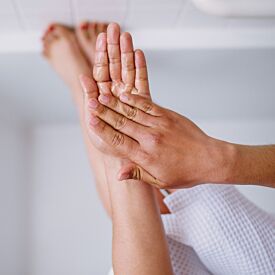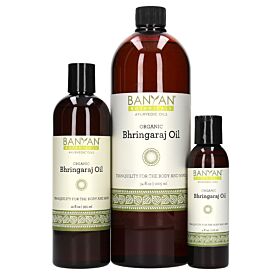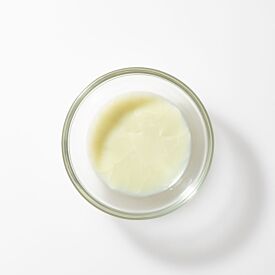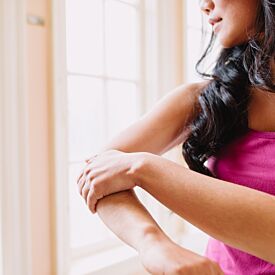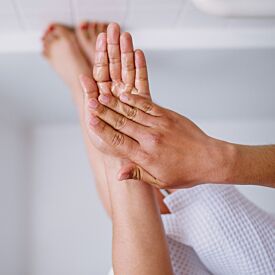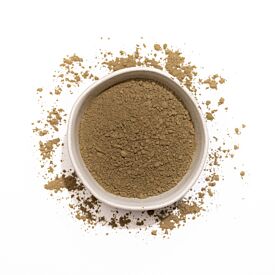Managing a Pitta-Kapha Constitution
Ayurveda recognizes the uniqueness of every single human being, and uses the three doshas of vata, pitta, and kapha to help us understand our individual needs. While some people are predominant in just one of the doshas, it’s helpful to remember that everyone is made up of all three. In fact, many people experience two or even three primary doshas within themselves.
Being a pitta-kapha type means that two doshas are predominant in your prakriti, or constitution, and these will likely be in a dynamic dance depending on the seasons, your lifestyle habits, and any external influences.
It is usually best to manage a dual dosha prakriti according to the season. In general, as a pitta-kapha, follow a pitta-pacifying regimen during the summer season when the weather is balmy and hot.
Follow a kapha-pacifying regimen during the winter and spring, especially when the weather is cool and damp. You can also take our dosha quiz at any time to see which dosha most needs your attention.
The Qualities of Pitta
“Pittam sasneha tikshnoshnam laghu visram, saram dravam”
Pitta is oily, sharp, hot, light, fleshy-smelling, spreading, and liquid.— Ashtanga Hrdayam: Sutrasthana I:11
This Sanskrit line lists the main qualities of pitta and provides a key to understanding what it means to have a predominantly pitta prakriti.
The main qualities of pitta are oily, sharp, hot, light, fleshy smelling, spreading, and liquid. So, having a pitta-predominant prakriti means that these qualities express themselves generously throughout your mental, emotional, and physical make up.
Here are some ways you may find them reflected in your strengths and weaknesses.
- The oily quality allows for softness of skin but, in excess, can manifest as oily skin, clogged pores, or perhaps the quality of being a “snake oil salesman” and manipulating situations to your advantage.
- The sharp quality may manifest as a sharp, bright intellect or, in excess, as a sharp tongue.
- “Hotness” can manifest as a warm, rosy complexion, warm body temperature, strong metabolism and appetite or, in excess, as burning digestion or a hot temper.
- The light quality may lead you to have a slender body or to get light-headed if you miss a meal.
- The “fleshy-smelling” quality may manifest as a strong body odor.
- The spreading quality may manifest as a tendency to spread your name or influence or opinion around the local or global neighborhood. This quality can also manifest as a spreading redness in the skin.
- The liquid quality may manifest as excess sweating. When combined with the hot quality it can also present as an acidic, burning sensation in the stomach.
Decreasing or Balancing Pitta
Like Increases Like
A basic tenet of Ayurveda is “like increases like.” Therefore, increasing the inherent qualities of pitta will increase pitta in your body, mind, and spirit.
For example, because pitta is inherently hot—hot weather, hot foods, the hot seasons and times of day, and even hot emotions can increase pitta. Likewise humid environments will increase the liquid quality and thereby increase pitta.
Example: You are a pitta individual. Pitta is hot in nature. You visit the equator for a vacation and you sunbathe every day and enjoy hot, spicy foods. At the end of the week you suffer from red, irritated skin and find yourself in an awful temper. Ayurveda would say that your heat-increasing indulgences increased the natural heat in your pitta constitution and lead to hot conditions “erupting” in your body and emotions.
Tastes That Increase and Decrease Pitta
Along with the main qualities of pitta, it is also helpful to know those tastes that increase pitta and those that decrease pitta.
- Pungent, sour, and salty tastes increase pitta, by increasing its hot quality. An example of the pungent taste is chili pepper; of sour, pickles; and of salty salt.
- Sweet, bitter, and astringent tastes will decrease pitta by providing the opposite qualities to those of pitta. An example of naturally sweet taste is wheat; of bitter and astringent (which are often coupled), many leafy greens and herbs.
Using Opposites to Maintain Balance
Each of us has a unique proportion of the three doshas in our prakritis. Ayurveda teaches us that if a dosha increases beyond its original, natural proportion for our unique constitution, it fosters an environment where disease can flourish.
It is common for our predominant dosha (vata, pitta, or kapha) to increase more quickly than other doshas because we tend to perpetuate what we know the best.
For example, if your dominant dosha is pitta, you may be intellectually bright, due to the hot and sharp qualities of pitta. However, this very quality that is inherent in pitta may eventually aggravate it and create mental or physical “burn out.”
If a dosha increases in our bodies, Ayurveda suggests that we decrease it in order to regain a healthy balance.
To do so, we want to incorporate substances which decrease the excess dosha by providing the opposite qualities. For example, if excess mental wrestling has resulted in “burn out,” a comfortable, soft couch and a cool mind can bring a return to balance. If pitta has increased due to excess heat, coolness is in order. Too much moisture? Use dryness.
One of the wonderfully practical aspects of Ayurveda is that anything can be used to restore balance because everything that exists has a quality. This includes but is not limited to: herbs, foods, drinks, environments, colors, smells, and lifestyles.
Qualities opposite to pitta are those that are dry, soft, cool, heavy, sweet smelling, and contained. It is therefore best for pitta individuals to seek out physical and emotional environments, routines, and foods that possess these opposite qualities.
Dietary Support to Balance Pitta
A pitta individual does well to have fresh, cooling foods. They have difficulty skipping meals because they tend to have strong appetites.
Because they also have strong digestive systems, they tend to tolerate raw foods better than the other doshas but they must be careful to avoid hot foods, alcohol, caffeine, and fried foods, as these will create too much pitta and weaken the digestive system.
Because the sweet, bitter, and astringent tastes decrease pitta, these tastes should be predominant in your diet.
Note that this is not necessarily a green light to eat refined sugary foods and drinks. The naturally sweet taste that is found in many grains, squashes, natural sweeteners and fruits is most appropriate and effective for balancing pitta.
Herbal Support to Balance Pitta
Using herbs to manage your constitution compliments the changes you make in your diet and lifestyle and can be incredibly supportive in promoting overall health.
Brahmi, bhringaraj and guduchi are three of the primary herbs used to remove excess pitta from the body and maintain balance. All of these herbs can be found in our Healthy Pitta tablets.
Climate and Lifestyle to Balance Pitta
The ideal environment for a pitta individual is cool and dry, such as a cool mountain climate. Sweet scents, melodic music, and sweet emotions are also wonderful for pitta.
A daily, 10–20 minute gentle self-massage with warm sunflower oil or Pitta Massage Oil will cool the heat of pitta and support you in "going with the flow" rather than using your will to force the flow.
It is easy for the pitta individual to feel that, if they just work long and hard enough, they can control everything. This tendency may lead them to strive for control and personal domination in their relationships or career, and may drive them into eventual mental or physical "burn out."
One of the best medicines for pitta is surrender. If you can develop a gentle faith in—or relationship with—a divine power or natural force that you believe can do a fine job of orchestrating personal and universal life, then you can take some pressure off yourself.
For this reason, it is beneficial for a pitta individual to enjoy regular meditation. (And really enjoy it—not just do it as if it is another task they need to master).
Yoga for Pitta Types
The practice of yoga goes hand in hand with Ayurveda. Visit the pitta-pacifying yoga section on our website for information on how to customize your yoga practice to cool the body, calm the mind, and help balance excess pitta.
Famous Pitta Examples
Madonna: Sharp businesswoman. World-famous. Ambitious. Moderate build.
Bill Gates. Sharply intelligent. His fame has spread everywhere, even beyond his own professional sphere. Ambitious. Balding.
The Qualities of Kapha
“Snigdhah shita gururmandah shlakshno mritsnah sthirah kaphah”
Kapha is unctuous, cool, heavy, slow, smooth, soft, and static.— Ashtanga Hrdayam: Sutrasthana I:12
This Sanskrit line lists the main qualities of kapha and provides a key to understanding what it means to have a predominantly kapha prakriti.
The kapha personality and characteristics will reflect kapha's earthy qualities—unctuous, cool, heavy, slow, smooth, soft, and stable. It is also dense, cloudy, and viscous. So having a kapha-predominant prakriti means that these qualities express themselves generously throughout your mental, emotional, and physical make up.
Here are some ways you may find these qualities reflected in your strengths and weaknesses.
- The unctuous quality can allow for smooth joint function but, if pronounced, can lead to excess buildup of bodily fluids.
- The cool quality may manifest as cool skin and a laid-back, cool temperament.
- Heaviness may manifest as a large, sturdy, grounded physical and emotional constitution and, in excess, as being overweight or experiencing a subjective feeling of heaviness in the mind.
- Slowness may manifest as a slow gait or a slow, steady pace that you can maintain. In excess, you may get stuck in a pattern that is not healthy and supportive for you.
- Softness can manifest as a soft heart that is easily empathic. Another manifestation of this quality is having soft skin.
- Stability can be an asset that friends, family, and colleagues probably recognize and lean on, but in excess it can turn to stubbornness or sluggishness. You could become so stable that you are disinclined toward any physical activity.
- Density can manifest as good stamina and strong, well-formed muscles and bones. This enables the kapha constitution to withstand vigorous exercise. This quality is also responsible for dense, luxurious hair.
Decreasing or Balancing Kapha
Like Increases Like
As discussed above, a basic tenet of Ayurveda is “like increases like.” Therefore, increasing the inherent qualities of kapha will increase kapha in your body, mind, and spirit.
For example, because kapha is inherently cool, heavy, and wet—cold weather, heavy foods, or wet seasons tend to increase kapha. Knowing this can help identify which lifestyle choices, foods, or environments will bring balance to your constitution.
Example: You are a kapha individual. Kapha is heavy, dense, wet, cold, and static. If you eat a large bowl of ice cream (heavy, dense, wet, and cold,) at night (cold) in winter in Vermont (cold, wet), you can be sure that kapha will increase in your system. The next morning you may find yourself with a cold, having gained a pound or two (the increase of heavy and dense), and less likely to move than ever (static).
Tastes That Increase and Decrease Kapha
Along with the main qualities of kapha, it is also helpful to know those tastes that increase or decrease kapha.
- Sweet, sour, and salty tastes increase kapha by increasing bulk and moisture in the body and mind, and by perpetuating the qualities of kapha. An example of the naturally sweet taste is wheat; of sour, a pickle; of salty, salt.
- The pungent, bitter, and astringent tastes traditionally decrease kapha by drying the body and providing the opposite qualities to those of kapha. An example of the pungent taste is chili pepper; of bitter and astringent (which are often coupled), many leafy greens and herbs.
Using Opposites to Maintain Balance
If your dominant dosha is kapha, its quality of slowness may lead you to be naturally inclined toward calming activities. In excess, this slow quality can lead to stagnation.
To regain healthy balance, we want to incorporate substances which decrease the excess kapha by providing the opposite qualities.
For example, if kapha has increased due to excess stagnation in your life, activity is the solution. If it has increased due to excess coolness, you can use heat to bring balance. Too much heaviness? Use lightness.
Qualities opposite to kapha are predominantly warm, dry, light, and active. It is therefore best for kapha individuals to seek out physical and emotional environments, routines, and foods that possess these opposite qualities.
Dietary Support to Balance Kapha
Because of the slow, heavy qualities of kapha, this dosha type can tend to have a sluggish digestive capacity and a slower metabolism. They usually don’t have a ravenous appetite but can experience heaviness after meals.
A kapha individual does well to have a moderate amount of warming, light, freshly cooked foods to maintain balance and support healthy diestion. Because pungent, bitter, and astringent tastes decrease kapha, these tastes should be predominant in your diet.
Herbal Support to Balance Kapha
Using herbs to manage your constitution compliments the changes you make in your diet and lifestyle and can be incredibly supportive in promoting overall health.
Bibhitaki, chitrak and punarnava are three of the primary herbs used to remove excess kapha from the body and maintain balance. All of these herbs can be found in our Healthy Kapha tablets.
Climate and Lifestyle to Balance Kapha
Although kapha may be able to tolerate a wide variety of temperatures, the ideal environment is a warm and dry one. Active sports like jogging, hiking, biking, or competitive sports, especially in the morning, are best. These activities will get the blood moving and the heart pumping, helping to keep kapha motivated and light.
Aromatic, invigorating, or heating scents, and light and lively music are also great for kapha. A vigorous, daily 10–20 minute self-massage with warm sesame oil or Kapha Massag Oil will help keep kapha from becoming stagnant.
One of the best things for kapha is activity. It is well worth the effort for the kapha individual to find that golden key to what motivates them. For example, if you have a difficult time motivating yourself to exercise regularly, you could enter yourself in a local bike race. This may give you just that extra push and you may be surprised by how much you enjoy yourself.
Yoga for Kapha Types
The practice of yoga goes hand in hand with Ayurveda. Visit the kapha-pacifying yoga section on our website for information on how to customize your yoga practice to warm your body, uplift your spirits, and help keep kapha balanced.
Famous Kapha Examples
Oprah Winfrey: Large, luminescent eyes and frame. Compassionate. Generous.
Luciano Pavarotti: Deep, resonant voice. Large frame.
Now What?
Knowing our prakriti is useful because it increases awareness of our natural strengths and challenges. This is a positive first step towards understanding health.
The second step is to understand if and how we have strayed from our natural, healthy constitution. In Ayurveda, we determine this by comparing our prakriti (natural constitution) with our vikriti (current condition). If you have not already, take the dosha quiz to determine your current state of balance and get started on your path to optimal well-being.
COPYRIGHT
The above information was written by Dr. Claudia Welch for the exclusive use of Banyan Botanicals. The information is protected by copyright and may not be reprinted without the written permission of Dr. Claudia Welch and Banyan Botanicals.
DISCLAIMER
The above prakriti test and results are intended as a convenient tool to provide practical information on your Ayurvedic constitutional type. It is not intended to diagnose, treat, cure or prevent any disease. In addition, it should be noted that while this information should be considered highly useful it is not meant to replace the skilled constitutional analysis of a professionally trained Ayurvedic Physician.



